人教新目标(Go for it)版七年级英语上册Unit5Do you have a soccer ball? Section A(Grammar Focus-3c) 课件(用office打开)
文档属性
| 名称 | 人教新目标(Go for it)版七年级英语上册Unit5Do you have a soccer ball? Section A(Grammar Focus-3c) 课件(用office打开) | 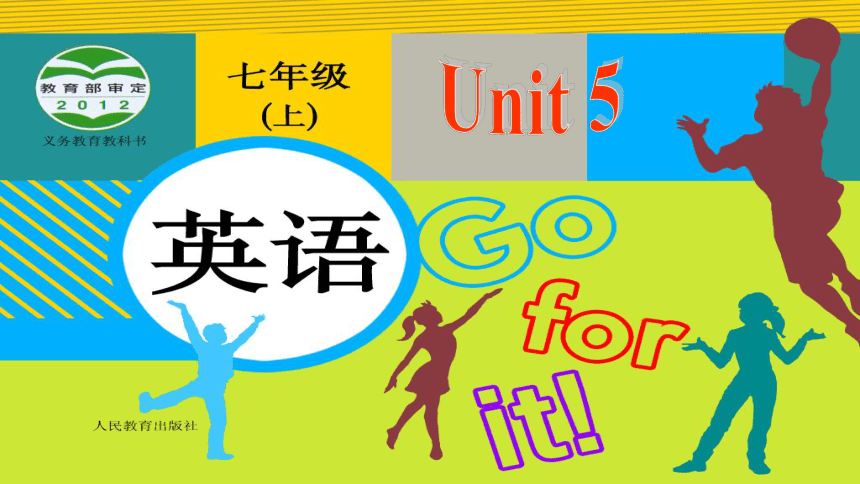 | |
| 格式 | zip | ||
| 文件大小 | 1.4MB | ||
| 资源类型 | 教案 | ||
| 版本资源 | 人教新目标(Go for it)版 | ||
| 科目 | 英语 | ||
| 更新时间 | 2021-10-28 17:32:20 | ||
图片预览

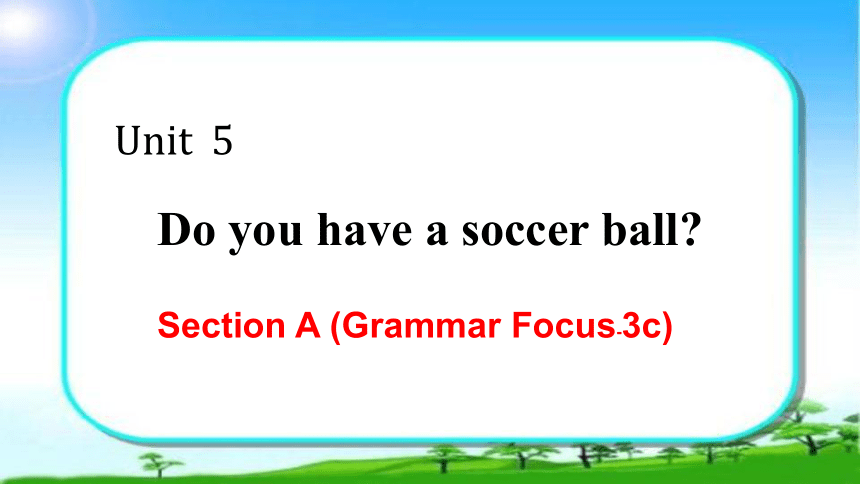
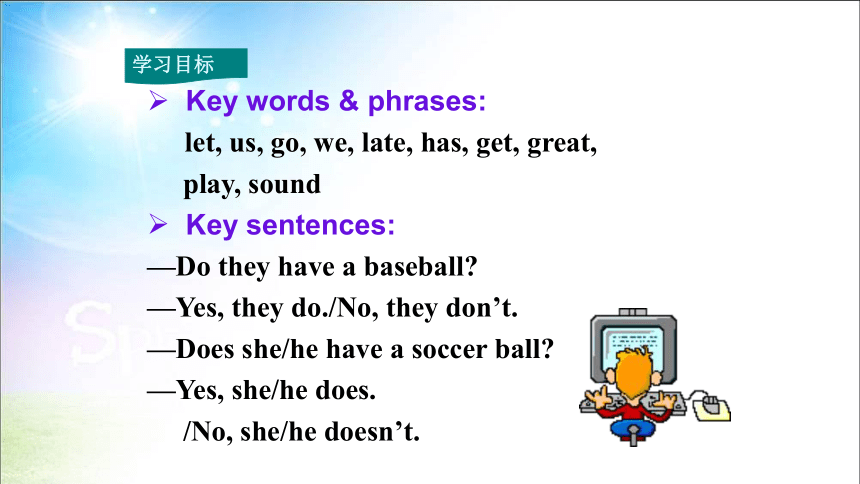
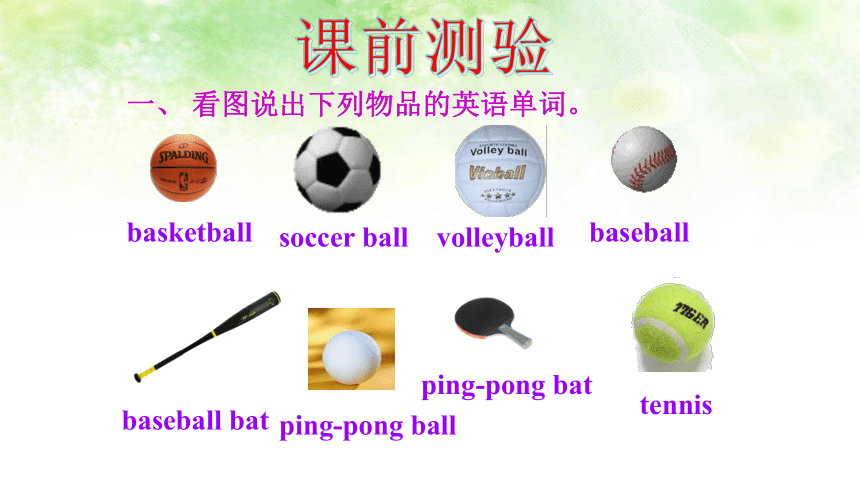
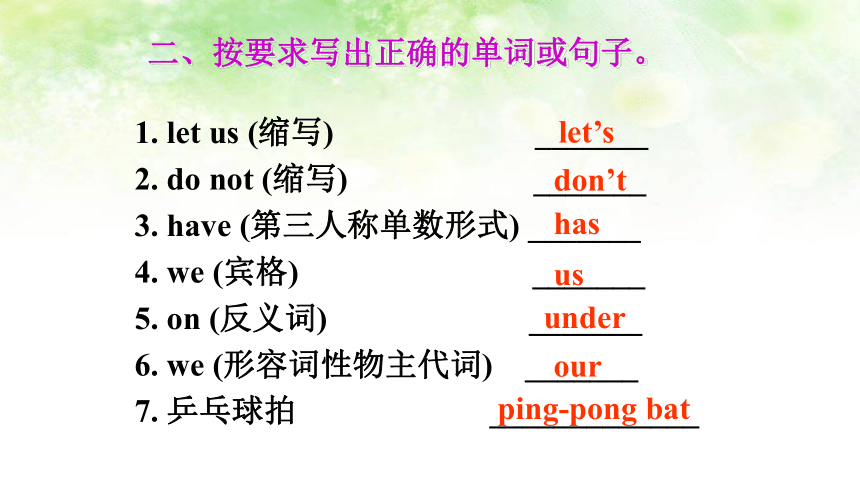
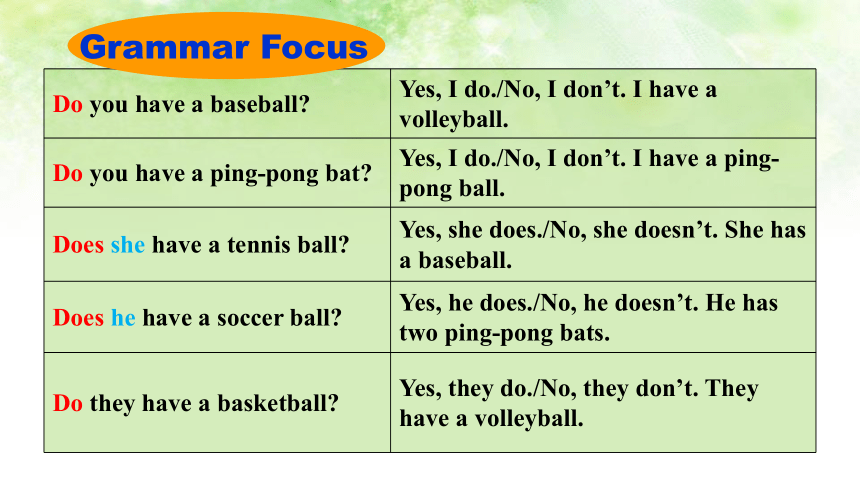
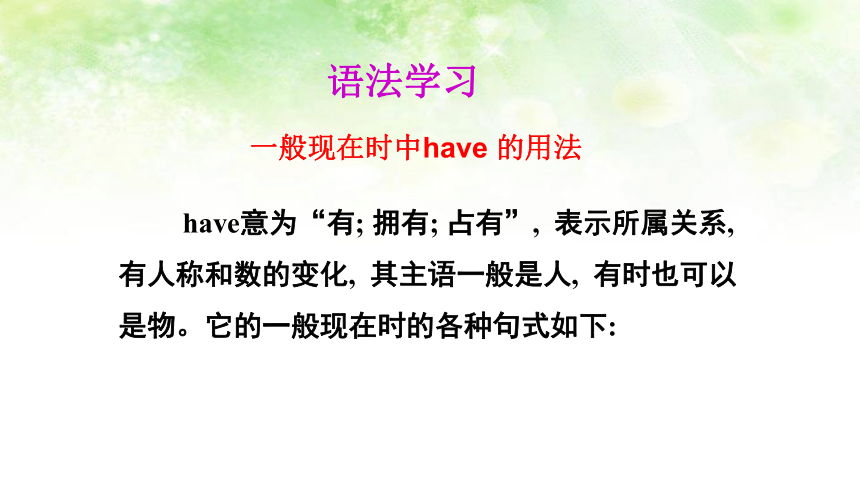

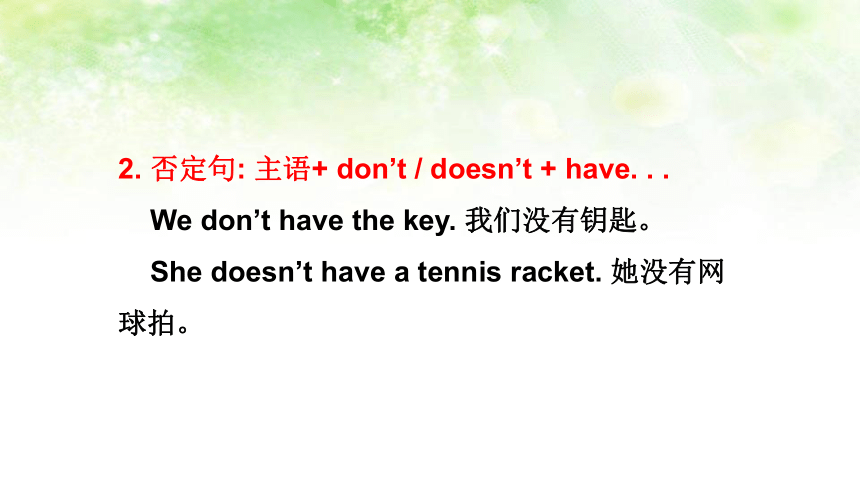
文档简介
(共25张PPT)
Unit 5
Section A (Grammar Focus-3c)
Unit 5
Do you have a soccer ball
学习目标
Key words & phrases:
let, us, go, we, late, has, get, great,
play, sound
Key sentences:
—Do they have a baseball
—Yes, they do./No, they don’t.
—Does she/he have a soccer ball
—Yes, she/he does.
/No, she/he doesn’t.
一、 看图说出下列物品的英语单词。
basketball
soccer ball
volleyball
baseball
baseball bat
ping-pong ball
ping-pong bat
tennis
课前测验
let us (缩写) _______
do not (缩写) _______
3. have (第三人称单数形式) _______
4. we (宾格) _______
5. on (反义词) _______
6. we (形容词性物主代词) _______
7. 乒乓球拍 _____________
don’t
has
under
let’s
二、按要求写出正确的单词或句子。
us
our
ping-pong bat
Do you have a baseball Yes, I do./No, I don’t. I have a volleyball.
Do you have a ping-pong bat Yes, I do./No, I don’t. I have a ping-pong ball.
Does she have a tennis ball Yes, she does./No, she doesn’t. She has a baseball.
Does he have a soccer ball Yes, he does./No, he doesn’t. He has two ping-pong bats.
Do they have a basketball Yes, they do./No, they don’t. They have a volleyball.
Grammar Focus
语法学习
一般现在时中have 的用法
have意为“有; 拥有; 占有”, 表示所属关系, 有人称和数的变化, 其主语一般是人, 有时也可以是物。它的一般现在时的各种句式如下:
1. 肯定句: 主语+ have/has. . .
have用于复数名词、第一、二人称单复数或第三人称复数代词作主语的句子中; has为have的第三人称单数形式, 用于不可数名词、可数名词单数或第三人称单数代词作主语的句子中。
You have many good habits. 你有很多好习惯。
Tom has three baseballs. 汤姆有三个棒球。
2. 否定句: 主语+ don’t / doesn’t + have. . .
We don’t have the key. 我们没有钥匙。
She doesn’t have a tennis racket. 她没有网球拍。
3.一般疑问句:Do/Does+主语+have…??
肯定答语:Yes, 主语 + do/does.
否定答语: No, 主语 + don't/doesn't.?
—Do you have a bike 你有自行车吗??
—Yes ,I do./No,I don’t.是的,我有。/不,我没有。
①当have/has后的名词被some修饰时,在否定句和
疑问句中some一般要改为any。
Do you have any money 你有钱吗?
②have/has与 there be当“有”讲时的区别:
have/has与主语为所属关系,强调的是某人“拥有;占有”某物,主语一般为名词或代词;there be句型强调的是一种客现存在的事实,为there引导的倒装句。
Practice
(中考真题)Alice has a tennis bat. (改为一般疑问句)
______ Alice _____ a tennis bat
Does
have
I
they
he
she
it
Eric
you
we
I he they you
we she it Eric
Write each word in the correct place
in the chart.
do does
I, they,you,we he,she, it, Eric
3a
Fill in the blanks with do or does. Then
practice the conversations with your partner.
A: you have a baseball
B: Yes, I .
A: Great! I have a bat. Let’s play!
Conversation 1
Do
do
3b
A: John have a soccer ball
B: No, he .
A: he have a ping-pong bat
B: Yes, he . I think he has a ping-pong ball, too.
A: Hmm…let’s ask.
Conversation 2
Does
doesn’t
Does
does
A: your friends have a basketball
B: Yes, they . They have two basketballs.
A: Well, let’s play basketball.
B: That sounds good.
Conversation 3
Do
do
Practice the conversations with your partner.
1. A: Do you have a baseball
B: Yes, I do.
A: Great! I have a bat. Let’s play.
2. A: Does John have a soccer ball
B: No, he doesn’t.
A: Does he have a ping-pong bat
B: Yes, he does. I think he has a ping-pong
ball, too.
A: Hmm … let’s ask.
Pairwork
3. A: Do your friends have a basketball
B: Yes, they do. They have two
basketballs.
A: Well, let’s play basketball.
B: That sounds good.
祈使句主要用来表示请求、命令、叮嘱、
号召等,谓语动词用原形。
标点符号一般用感叹号或句号,视说话
的语气而定。祈使句一般都用降调。
Let’s 句子就是一种祈使句, 表示建议。
如:
Let’s play soccer. 我们踢足球吧。
祈使句
Language points
2. That sounds good. 听起来不错。
sound在句中作系动词, 意为“听起来”,其后接形容词。第三人称单数形式为sounds。
e.g. The music sounds beautiful.
音乐听起来很美妙。
The idea sounds great.
这个主意听起来很棒。
【拓展】
sound作名词时,意为“声音”。 如:
the sound of music 音乐之声
一、根据句意及汉语提示完成单词。
1. Do you have a _________ (棒球)
2. Nick _______ (有) a new ping-pong bat.
3. Let’s _______ (去) to the teachers’ room.
4. Can Ms Smith teach _____ (我们) English
5. That ________ (听起来) great.
6. Let’s play __________ (篮球) with Mike and Jack.
baseball
has
go
us
sounds
basketball
课堂检测
7. Don’t be _____ (迟到) again, Sun Wei.
8. Ms Sun is a _______ (伟大的) teacher.
9. My sister always ______ (玩耍) with
our lovely cat.
10. There are (有) two new __________ (排球) on the desk.
great
plays
volleyballs
late
二、句型转换。
1. I have a baseball bat. (改为一般疑问句)
_______ _______ _______ a baseball bat
2. My brother has a soccer ball. (改为一般疑问句)
_____ your brother ______ a soccer ball
3. Do your friends have a volleyball (作肯定回答)
_______, _______ ____.
4. Does Mr. Smith have a brother (作否定回答)
______, _____ _______.
5. My hat is on the chair. (对划线部分提问)
_______ ______ _____ hat
Do you have
Does have
Yes they do
No he doesn’t
Where is my
空白演示
单击输入您的封面副标题
Unit 5
Section A (Grammar Focus-3c)
Unit 5
Do you have a soccer ball
学习目标
Key words & phrases:
let, us, go, we, late, has, get, great,
play, sound
Key sentences:
—Do they have a baseball
—Yes, they do./No, they don’t.
—Does she/he have a soccer ball
—Yes, she/he does.
/No, she/he doesn’t.
一、 看图说出下列物品的英语单词。
basketball
soccer ball
volleyball
baseball
baseball bat
ping-pong ball
ping-pong bat
tennis
课前测验
let us (缩写) _______
do not (缩写) _______
3. have (第三人称单数形式) _______
4. we (宾格) _______
5. on (反义词) _______
6. we (形容词性物主代词) _______
7. 乒乓球拍 _____________
don’t
has
under
let’s
二、按要求写出正确的单词或句子。
us
our
ping-pong bat
Do you have a baseball Yes, I do./No, I don’t. I have a volleyball.
Do you have a ping-pong bat Yes, I do./No, I don’t. I have a ping-pong ball.
Does she have a tennis ball Yes, she does./No, she doesn’t. She has a baseball.
Does he have a soccer ball Yes, he does./No, he doesn’t. He has two ping-pong bats.
Do they have a basketball Yes, they do./No, they don’t. They have a volleyball.
Grammar Focus
语法学习
一般现在时中have 的用法
have意为“有; 拥有; 占有”, 表示所属关系, 有人称和数的变化, 其主语一般是人, 有时也可以是物。它的一般现在时的各种句式如下:
1. 肯定句: 主语+ have/has. . .
have用于复数名词、第一、二人称单复数或第三人称复数代词作主语的句子中; has为have的第三人称单数形式, 用于不可数名词、可数名词单数或第三人称单数代词作主语的句子中。
You have many good habits. 你有很多好习惯。
Tom has three baseballs. 汤姆有三个棒球。
2. 否定句: 主语+ don’t / doesn’t + have. . .
We don’t have the key. 我们没有钥匙。
She doesn’t have a tennis racket. 她没有网球拍。
3.一般疑问句:Do/Does+主语+have…??
肯定答语:Yes, 主语 + do/does.
否定答语: No, 主语 + don't/doesn't.?
—Do you have a bike 你有自行车吗??
—Yes ,I do./No,I don’t.是的,我有。/不,我没有。
①当have/has后的名词被some修饰时,在否定句和
疑问句中some一般要改为any。
Do you have any money 你有钱吗?
②have/has与 there be当“有”讲时的区别:
have/has与主语为所属关系,强调的是某人“拥有;占有”某物,主语一般为名词或代词;there be句型强调的是一种客现存在的事实,为there引导的倒装句。
Practice
(中考真题)Alice has a tennis bat. (改为一般疑问句)
______ Alice _____ a tennis bat
Does
have
I
they
he
she
it
Eric
you
we
I he they you
we she it Eric
Write each word in the correct place
in the chart.
do does
I, they,you,we he,she, it, Eric
3a
Fill in the blanks with do or does. Then
practice the conversations with your partner.
A: you have a baseball
B: Yes, I .
A: Great! I have a bat. Let’s play!
Conversation 1
Do
do
3b
A: John have a soccer ball
B: No, he .
A: he have a ping-pong bat
B: Yes, he . I think he has a ping-pong ball, too.
A: Hmm…let’s ask.
Conversation 2
Does
doesn’t
Does
does
A: your friends have a basketball
B: Yes, they . They have two basketballs.
A: Well, let’s play basketball.
B: That sounds good.
Conversation 3
Do
do
Practice the conversations with your partner.
1. A: Do you have a baseball
B: Yes, I do.
A: Great! I have a bat. Let’s play.
2. A: Does John have a soccer ball
B: No, he doesn’t.
A: Does he have a ping-pong bat
B: Yes, he does. I think he has a ping-pong
ball, too.
A: Hmm … let’s ask.
Pairwork
3. A: Do your friends have a basketball
B: Yes, they do. They have two
basketballs.
A: Well, let’s play basketball.
B: That sounds good.
祈使句主要用来表示请求、命令、叮嘱、
号召等,谓语动词用原形。
标点符号一般用感叹号或句号,视说话
的语气而定。祈使句一般都用降调。
Let’s 句子就是一种祈使句, 表示建议。
如:
Let’s play soccer. 我们踢足球吧。
祈使句
Language points
2. That sounds good. 听起来不错。
sound在句中作系动词, 意为“听起来”,其后接形容词。第三人称单数形式为sounds。
e.g. The music sounds beautiful.
音乐听起来很美妙。
The idea sounds great.
这个主意听起来很棒。
【拓展】
sound作名词时,意为“声音”。 如:
the sound of music 音乐之声
一、根据句意及汉语提示完成单词。
1. Do you have a _________ (棒球)
2. Nick _______ (有) a new ping-pong bat.
3. Let’s _______ (去) to the teachers’ room.
4. Can Ms Smith teach _____ (我们) English
5. That ________ (听起来) great.
6. Let’s play __________ (篮球) with Mike and Jack.
baseball
has
go
us
sounds
basketball
课堂检测
7. Don’t be _____ (迟到) again, Sun Wei.
8. Ms Sun is a _______ (伟大的) teacher.
9. My sister always ______ (玩耍) with
our lovely cat.
10. There are (有) two new __________ (排球) on the desk.
great
plays
volleyballs
late
二、句型转换。
1. I have a baseball bat. (改为一般疑问句)
_______ _______ _______ a baseball bat
2. My brother has a soccer ball. (改为一般疑问句)
_____ your brother ______ a soccer ball
3. Do your friends have a volleyball (作肯定回答)
_______, _______ ____.
4. Does Mr. Smith have a brother (作否定回答)
______, _____ _______.
5. My hat is on the chair. (对划线部分提问)
_______ ______ _____ hat
Do you have
Does have
Yes they do
No he doesn’t
Where is my
空白演示
单击输入您的封面副标题
同课章节目录
- starters 预备篇(2012秋审查)
- Unit 1 Good morning !
- Unit 2 What’s this in English?
- Unit 3 What color is it ?
- Unit 1 My name's Gina.
- Section A
- Section B
- Unit 2 This is my sister.
- Section A
- Section B
- Unit 3 Is this your pencil?
- Section A
- Section B
- Unit 4 Where's my schoolbag?
- Section A
- Section B
- Unit 5 Do you have a soccer ball?
- Section A
- Section B
- Unit 6 Do you like bananas?
- Section A
- Section B
- Unit 7 How much are these socks?
- Section A
- Section B
- Unit 8 When is your birthday?
- Section A
- Section B
- Unit 9 My favorite subject is science.
- Section A
- Section B
